Bodhipaksa's Blog, page 7
October 15, 2014
Earworms and meditation
 Earworms are those tunes that get stuck in your head. Sometimes you’ll be meditating and have a favorite song stuck on replay. Sometimes it’s a song you hate. Either way, earworms aren’t very helpful to our meditation practice. In fact they can be so persistent that they drive us nuts!
Earworms are those tunes that get stuck in your head. Sometimes you’ll be meditating and have a favorite song stuck on replay. Sometimes it’s a song you hate. Either way, earworms aren’t very helpful to our meditation practice. In fact they can be so persistent that they drive us nuts!
Over the years I’ve tried a whole bunch of techniques to try to get rid of ear-worms. I’ve tried just listening to the song, accepting its presence and using it as an object of meditation, but songs can be intoxicating and I’ve found that I don’t develop much mindfulness and end up rocking out.
Sometimes I’ve listened to the lyrics closely to see if they’re trying to teach me anything, and from time to time I’ve been surprised to find that in some way I hadn’t expected the words of the song are deeply meaningful for me at that moment. That hasn’t necessarily made the song go away, but it’s given me something to reflect on.
I’ve tried imagining that I have a volume control in my head. I visualize turning this slowly from 10 down to 0. As I do so, I hear the song fade out. But then a few moments later I hear it fading back in again.
Finally I came up with an effective approach to earworms. It’s really simple: listen. Really listen.
Listen very attentively to the sounds around you. Include them in your meditation practice. In fact paying mindful attention to them becomes your meditation practice. Sounds make as good an object of meditation as anything else, so doing this isn’t a “distraction” from meditation but going deeper into meditation.
Listen in all directions at once. Listen to sounds in front of you and behind you, to the left and right, above and below. Let your auditory attention feel like it’s being stretched in every direction at once.
Allow all sounds to enter your awareness, rather than focusing on one individual sound, or moving from one sound to another.
Listen 100%.
The thing is that you can’t listen to the external world in this way and also listen to yourself singing internally. When you’re completely listening to the sounds around you, you can’t create an earworm. Listen intensely enough, and your mind becomes silent.
Whenever your attention begins to drift from the sounds outside, you’ll start to notice the earworm again. Now this might seem like a bad thing, but it’s actually wonderful, because now you have a built-in mindfulness meter! When the earworm appears, it’s letting you know that your mindfulness has slipped a little. So now the earworm is actually helping you to meditate, and instead of seeing it as annoying you can now be grateful toward it.
A sense of playfulness around this whole thing is important. Don’t see it as a test: you can’t fail. See it as just a game, so that you enjoy both the times you are able to pay attention to sounds, and the times that the earworm comes along and gently reminds you to come back to mindful awareness.
Related posts:
Day 17 of Wildmind’s 100 Day Meditation Challenge
Listening as a meditation practice
Mindfulness and the big picture
Related posts brought to you by Yet Another Related Posts Plugin.
October 11, 2014
How to enter the stream
 What you need to do to become a stream entrant
What you need to do to become a stream entrant
There are certain things you need to do, and attitudes that you need to cultivate, if you’re going to set up the conditions for insight to arise.
You’ll need periods of intensive practice, such as going on retreat. And I don’t mean just getting away for the odd weekend, which is all some people say they can manage. You need to have intensive spells of meditation for a week, ten days, two weeks, preferably longer.
Sometimes we find it hard to have the time. I heard someone say that when you say you don’t have time to do something it’s not a statement of fact, it’s a statement of values. When we say we don’t have time to go on retreat, this is a statement of what we think is important. Certainly there are practical difficulties — if you have a young child it’s very hard to get away for those first few years — but with time (and willingness) we can overcome these difficulties.
You need to do a lot of work to become a more positive person. You need to get rid of the gross manifestations of greed, hatred, and delusion. You need to be reasonably ethical. You need to work on being kind. You need to take responsibility for yourself. You have to have done a lot of letting go. You need to work on bringing Buddhist practice into your daily life. Your practice can’t be a hobby, and has to be the central orienting principle in your life. So your life has to be your practice. Your work has to be your practice, your parenting has to be your practice, your parenting and your friendships have to be your practice. Every aspect of your life has to become an avenue for cultivating mindfulness, compassion, and insight.
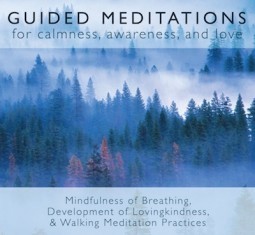 If you like my articles and want to support the work I do, please click here to check out my books, guided meditation CDs, and MP3s. Or you can make a donation.You’re going to need a sangha to do all of the above. We need other people to encourage us — and to challenge us. It’s all too easy for us to kid ourselves on about how spiritual we are, or to let ourselves off the hook when we face a spiritual challenge. A sangha holds a mirror up in front of us, so that we can see ourselves more clearly.
If you like my articles and want to support the work I do, please click here to check out my books, guided meditation CDs, and MP3s. Or you can make a donation.You’re going to need a sangha to do all of the above. We need other people to encourage us — and to challenge us. It’s all too easy for us to kid ourselves on about how spiritual we are, or to let ourselves off the hook when we face a spiritual challenge. A sangha holds a mirror up in front of us, so that we can see ourselves more clearly.
You need to have an enquiring mind. It’s very difficult to develop insight if you’re not prepared to question. And by this I don’t mean making a pain of yourself and arguing about everything. Gaining insight is about questioning your experience and questioning your assumptions about the world — your assumptions about where happiness comes from, your assumptions about who you are, your assumptions about things having permanence. Unless you’re prepared to question, you can’t break the fetters.
The enquiring mind is not afraid of uncertainty. In fact the enquiring mind thrives on uncertainty. I think a lot of what holds people back is too quickly assuming that they understand. It’s so easy to assent to Buddhist concepts, and being clever and having a quick mind can be a problem as well as a blessing. It’s easy to take ideas on board because they seem reasonable, without really thinking them through. The reason I decided to go study Buddhism at university was after I started noticing this in myself. I discovered that I could hold two contradictory ideas in my head at the same time. I could switch seamlessly from one to the other without ever noticing the contradiction, and I wanted an opportunity to be forced to think clearly. To give one example, it’s common to hear that the “eastern tradition” is that we should never talk about spiritual accomplishments such as enlightenment. So if we get enlightened we should be modest and never say anything about it. And then five minutes later we’ll read a sutta where the Buddha, or one of his disciples, proclaims his spiritual attainment, and think how wonderfully confident this all is. Another example would be believing that we literally have to aim to save all sentient beings in order to awaken, and in the next moment reading the Buddha’s life story in which he first gets awakened and then feels impelled to teach and help others. Often we never notice that we have two contradictory ideas in our mind, since each is only evoked under specific circumstances.
Stream entry involves breaking three fetters
Stream entry involves breaking three out of the ten fetters that hold us back from full awakening. These fetters are habits and views and acts of clinging that stop us from making progress.
The first fetter is “self-view.” It’s often expressed as “fixed self-view.” This is the assumption we have that we have a fixed and separate self that’s running the show of our lives. It’s not just that if we think we can’t change, we won’t, although that is true. This fetter is rather more subtle than that. It’s the view that there is a self that is somehow separate from our ever-changing experiences. So we may notice that our experiences are changing, but assume there’s some kind of stable, permanent self that has those experiences. But where could this kind of self lie?
To break this fetter, we have to simply notice, over and over again, that there’s nothing permanent in our experience. It’s not that we just understand impermanence intellectually. That’s often what we do. We talk about impermanence rather than just looking.
We watch our physical sensations. over and over, and see that they’re changing. We enquire. We look deeply. We question assumptions. So we find ourselves thinking “I’ve had this headache all day.” Well, actually you haven’t. Look closer. You’ve had it for a microsecond. Before that you had a slightly different headache for a microsecond. You’ve had a gazillion headaches, all a microsecond long, and each one different. So you notice this endless parade of headaches, coming and going, pulsing and throbbing. You come to realize that the headache is not a permanent thing. At some point you realize that everything that constitutes our sense of self is like that. Even the consciousness that notices the headaches coming and going is changing all the time. There’s nothing here but change. There’s no room for the kind of permanent self that we assume “has” our experiences.
This fetter, although we call it “(fixed) self view” is literally the fetter of “real body view” (sakk?ya ditthi) and this literal sense of the term is an important component of the fetter. At a certain point we lose the sense of having a body, and instead we experience ourselves as a mass of ever-changing sensations. There’s a loss of the sense of solidity and permanence of the body. But this experience of the body dissolving doesn’t stop with the body. It extends to every aspect of our experience, and even to our sense of self.
So this is all you need to do. Just look. Notice that everything’s changing. And keep doing this until the penny drops that all there is is change. It’s really simple. We do this with physical sensations, feelings, thoughts, etc.
The second fetter is doubt. All three fetters break at the same time, so this one goes automatically when the fetter of self view breaks. When we break the fetter of self view, we see everything’s changing. This is changing, that is changing, everything is changing. And then it clicks, there’s nothing here that’s permanent. There’s nothing solid in my self.
Now this is very liberating! We’ve been under the grip of a delusion all our lives — the delusion of having a fixed and separate self. There’s been doubt about all this Freudian stuff lurking under the surface. There’s been doubt that we may be fundamentally incapable of becoming enlightened because of all the baggage we’ve been dragging around. And there’s been doubt about whether Buddhist practice can even go beyond making us a bit happier. Now doubt vanishes. Now we have confidence — confidence that comes from the evidence of our senses. So where could there be doubt? Where could it exist? How can your baggage hold you back when it’s impermanent and insubstantial? You’ve seen the reality of not-self, and there’s no room for doubt. (There will be other doubts about other things, but this particular doubt has gone).
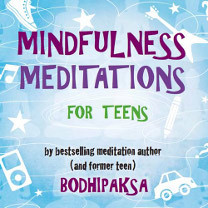 If you like my articles, please check out my books, guided meditation CDs, and MP3s.The third fetter is “dependence on ethics and religious observances.” The wording of this fetter is strangely complex compared to the others, and it’s also harder to connect this with an experience that happens at the same as the other two fetters break. But apart from the stunning insight that there is no substance to the self, and the surge of confidence we feel as doubt falls away, there’s one other powerful experience that happens at stream entry — a sense of the immediacy and obviousness of the insights we’ve just experienced. Now that we’ve seen, we wonder why we haven’t seen before. After all, the reality of the insubstantiality of the self is out there in the open, just waiting to be seen. The reality of impermanence is not exactly a secret. So there’s this sense of wonder that this is all so easy to do, and we puzzle over why we haven’t seen it before.
If you like my articles, please check out my books, guided meditation CDs, and MP3s.The third fetter is “dependence on ethics and religious observances.” The wording of this fetter is strangely complex compared to the others, and it’s also harder to connect this with an experience that happens at the same as the other two fetters break. But apart from the stunning insight that there is no substance to the self, and the surge of confidence we feel as doubt falls away, there’s one other powerful experience that happens at stream entry — a sense of the immediacy and obviousness of the insights we’ve just experienced. Now that we’ve seen, we wonder why we haven’t seen before. After all, the reality of the insubstantiality of the self is out there in the open, just waiting to be seen. The reality of impermanence is not exactly a secret. So there’s this sense of wonder that this is all so easy to do, and we puzzle over why we haven’t seen it before.
So how does this relate to dependence on ethics and religious observances? Basically, this fetter seems to refer to the practices we’ve done that have ended up being a distraction from seeing impermanence and seeing the insubstantiality of the self. We get caught up in external practices that are distractions, like trying to be a “good Buddhist” and trying to impress, and especially trying to understand intellectually rather than just looking and seeing what’s right there in front of us.
Of course we need, in a way, to rely on ethics and religious practices. But sometimes we use them as distractions. We cling to the form of our practice and forget the spirit. We keep forgetting, on some level, what the purpose of practice is. And actually all we have to do is look. And look again. And again. Until finally the penny drops.
Related posts:
“To see what is in front of one’s nose needs a constant struggle.” George Orwell
Six ways of reflecting on impermanence
Lovingkindness as a path to awakening (Day 25)
Related posts brought to you by Yet Another Related Posts Plugin.
The second arrow
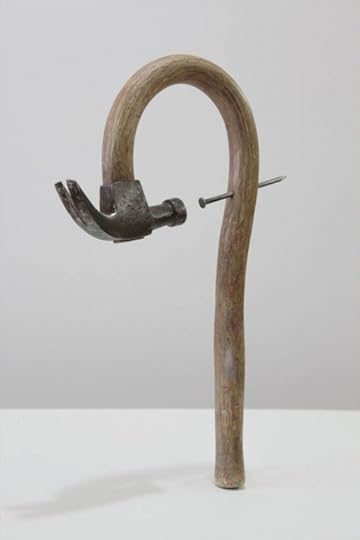
San Diego–based Seyo Cizmic is a surrealist artist who creates bizarre objects whose everyday uses have been subverted. This particular work is a striking reminder of the Buddha’s “two arrows” teaching, in which he points out that we take an initial instance of hurt and replay it over and over in our minds, magnifying and intensifying our pain. In other words, most of our suffering is caused by ourselves.
(Thanks to Caroline Hagerman on Google+ for bringing this image to my attention!)
Related posts:
Buddhism, grief, and loss
Three forms of suffering, reinterpreted
Self-hatred, self-compassion, and non-self
Related posts brought to you by Yet Another Related Posts Plugin.
October 10, 2014
Relax, rest, reveal
 Here’s a meditation tip for you to try. It came to me when I was on retreat a couple of weeks ago. One morning, on the first meditation of the day, I found that my mind was all over the place.
Here’s a meditation tip for you to try. It came to me when I was on retreat a couple of weeks ago. One morning, on the first meditation of the day, I found that my mind was all over the place.
I really needed to calm down my racing thoughts, but I had a hunch that the more I “tried” to do something about them, the more I was going to create more disturbance. In Buddhism we sometimes talk about this as being the task of “catching a feather on a fan,” because more effort equals more disturbance, while a gentle and sensitive effort will get the job done.
As I paid attention to the sense of my body letting go on each out-breath, I heard three words accompanying the exhalations. Breathing out, I’d hear “Relax.” Breathing out, I’d hear “Rest.” Breathing out, I’d hear “Reveal.”
Each of the words had a different effect. “Relax” would direct my mind to the sense of natural relaxation that takes place every time we breathe out. Focusing like this on the physical release that takes place when we exhale helps the body to relax more deeply.
The word “rest” encouraged my mind to let go. As I breathed out, my mind settled into a natural sense of ease, non-striving, kindness, and acceptance.
As I hears the word “reveal,” I experienced a sense of openness to whatever was arising in that moment, whether in the mind or the body. There was a gentle sense of attentiveness and mindfulness — a balance of receptivity and active observation.
These three words, cycling though my mind, gave me a series of little reminders, each as long as an out-breath: let go in the body; let go in the mind; notice and accept whatever’s arising.
Very quickly, my thoughts slowed down. That process started almost the moment that I started saying these three words.
After a little while I found I didn’t need to “hear” the words as thoughts. I could let the mind be silent. My thoughts had substantially died away, and yet even without the verbal reminder, on successive out-breaths I was still relaxing, resting the mind, and allowing my experience to reveal itself to me. And whenever my thoughts started to reappear, I was free to reintroduce the thoughts once more.
Do feel free to try this, and even to adapt it to your own needs. See what doesn’t work, and what does. Meditation is “open source,” and you can adapt it in the light of your own experience.
Related posts:
Some of your “distractions” are not distractions
Six ways of reflecting on impermanence
Day 21 of Wildmind’s 100 Day Meditation Challenge
Related posts brought to you by Yet Another Related Posts Plugin.
October 3, 2014
Mindfulness and the big picture
 Someone asked me:
Someone asked me:
I keep hearing about mindfulness where ones needs to pay attention to everything. But I am a bit confused and hoping someone can explain it to me in details. Am I supposed to be mindful of everything all at the same time? For example, every time I talk, I automatically remember to be careful about what words I should use. But how can one be mindful of everything all at the same time?
Actually, it’s not necessary, and usually not possible or desirable, to pay attention to everything at once. Right now I’m typing these words, and so I’m not paying attention to the sounds coming from outside the house. I could pause and listen to the sound of a passing airplane, but then I’d have to stop typing. So what’s my purpose — listening or typing? Right now I want to type.
But if I want to type, then I need to check my posture from time to time to make sure it’s going to support my purpose. If my posture had been trained to be perfect, then I wouldn’t need to do this. But it’s not perfect, so I pause for a second and check in with my body. I notice I’m slumping a little; I straighten up. What’s my purpose? Typing. Why am I paying attention to my posture? Because I want to type.
There’s a cluster of things I need to pay attention to if I want to type. I’ve mentioned posture, but I might in certain circumstances have to pause and reflect on what I’m going to say: that’s mindfulness of my thinking. I might have to pause and pay attention to how I feel. I might notice I’m tired and it’s time to rest.
Another example: My questioner mentioned being aware of the words he’s using in conversation. You need to do that. But you’d also want to be aware of the person you’re talking to, because you want to know what effect your words are having. Is the other person understanding you? What’s their emotional response to what you’re saying? To know that, you have to pay attention to them, and also to yourself — you’ll sense whether the other person is at ease by sensing whether you are at ease, for example.
And you need to be aware of what your response is to what they say to you. Again, you need to notice your feelings, what your thoughts are, etc.
Again, there’s a natural set of experiences that you need to pay attention to while you’re in a conversation with someone. The factors I’ve mentioned aren’t meant to be exhaustive. For example, sometimes when I’m listening to someone talk, my mind tends to wander to something I’m preoccupied with, and so I find it helpful to notice the movements of the breathing in my belly in order that I can stay grounded.
But when you’re in a conversation you probably don’t want to be paying attention to a passing airplane, to the sound of a ticking clock, or to another conversation that’s going on elsewhere. Those are distractions to your purpose, which is being in communication with the other person.
So what you do is dependent on what your overall purpose is. We don’t practice mindfulness for the sake of practicing mindfulness. Mindfulness isn’t an end in itself. It’s a tool. There are a few times we want to be open to everything that’s arising — for example in meditation — but that’s quite rare, and done as a form of training. Generally, you need to bear in mind what you’re actually doing (this is called sampajañña) and then pay attention to a set of experiences connected with that task (this is called sati).
I’m not suggesting being dogmatic, and sometimes you’ll need to shift your purpose. Having the attitude “I’m not going to pay attention to what my colleague is saying because I’m typing” isn’t helpful. There are higher-order purposes and you need to have some common sense. Harmony with others is one of those. If there’s an interruption from another person, you need to deal with it.
This need for higher order purposes is implicit in the Buddha’s eightfold path, of which mindfulness is just part. A key aspect of the eightfold path is the first, samma-ditthi, which is right view. It’s right view that gives us our overall context or purpose in life: for me the simplest way to look at this big picture is that Buddhism is about learning how we cause suffering for ourselves and others, so that we can find freedom from suffering. That view then carries over into the other factors of the path. To take just the example of the second factor of the path, samma sankappa, what emotions do we want to encourage and which do we want to discourage? Emotions of greed and hatred cause suffering. Compassion, patience, etc. free us from suffering. Right view tells us where we want to be headed, while mindfulness lets us know what we’re working with and monitors our progress. I don’t intend to do a full description of the eightfold path—just to illustrate that mindfulness traditionally has a broader context, and can’t be understood without reference to the big picture.
Mindfulness stripped of that context—stripped of its Buddhist context and secularized, as it often is—is still a useful tool, but it can also be confusing, as my questioner has found.
Related posts:
Using unhappiness as a mindfulness bell
Seven ways to teach your children mindfulness
Mindfulness of hunger
Related posts brought to you by Yet Another Related Posts Plugin.
October 1, 2014
If Buddhism teaches non-self (anatta), then who meditates?
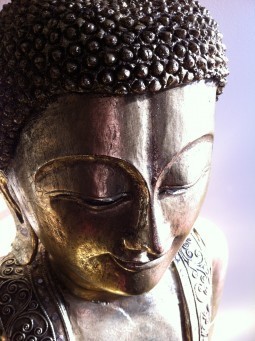 I was asked, “If Buddhism teaches non-self (anatta), then who is doing all this that happens in my life; who meditates?”
I was asked, “If Buddhism teaches non-self (anatta), then who is doing all this that happens in my life; who meditates?”
There is meditation taking place. There is stuff happening in life. There is the thought, “Someone is doing this.” But that thought is a bit like the idea primitive man may have felt, looking at nature. The wind blows, the leaves rustle, the rain falls. There must be “someone” making this all happen! And so they imagined a god or gods who were doing these things.
Nowadays we talk about all this being an “ecosystem.” But we don’t think of “Ecosystem” as a god who hides behind the scenes, making everything happen. There’s just a bunch of stuff happening, quite beautifully. It doesn’t need a central controller. Nor do we.
A thought or feeling arises within us, or an action takes place, and part of us thinks, “Who did that? Why, it must have been me!” We invent a sort of “inner god” who rules a very small universe, and who is in charge of “us.”
If this is still confusing, you might want to check out an article I wrote recently, “The empty room, the plagiarist, and the boys in the basement.” I hoped to make this topic more easily understandable.
Related posts:
Penn class teaches students how to live like monks
Buddhism, wealth, and happiness
Where the currents of construing do not flow (Day 94)
Related posts brought to you by Yet Another Related Posts Plugin.
September 30, 2014
Buddhism, grief, and loss
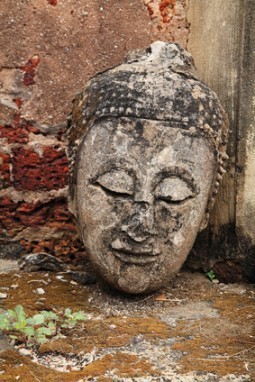 Recently a meditation student who’s only just begun practicing wrote to say that she’d experienced a bereavement. She wondered if I had any suggestions to help her through the grieving process.
Recently a meditation student who’s only just begun practicing wrote to say that she’d experienced a bereavement. She wondered if I had any suggestions to help her through the grieving process.
I have to say first of all that I’m not a grief counsellor. I’m just a meditator who has ended up sharing what he’s learned about working with pain. And I also would like to add that I’m hesitant to give advice in such situations because I know how feeble words can be in the face of powerful emotions. I long ago gave up on the notion I once held that there is some magical form of words that will make everything better.
Despite that, though, I know that sometimes when we share our perspectives with others (or when they do this with us) it can be helpful. So here’s an edited version of what I wrote to her.
Grief can of course be very painful. I think the main thing I’d emphasize is that the pain of loss is very natural, and to be accepted. It’s common to think that there’s something wrong when we feel pain, but when our life has been deeply entangled with that of another being, the two of us are part of one emotional system — a kind of shared love that flows between us. In that kind of a relationship we’re not, on an emotional level, two entirely separate beings. And so when we lose the other, it feels like a part of us has been ripped out. It feels that way because that’s exactly what’s happened.
So take a breath, and say, “It’s OK to feel this.” It really is.
Even those who are enlightened feel grief.
Just as one would put out a burning refuge with water, so does the enlightened one — discerning, skillful, and wise — blow away any arisen grief, his own lamentation, longing, and sorrow, like the wind, a bit of cotton fluff.
The Sutta Nipata
When we think there’s something wrong about feeling grief, then we add a second layer of suffering, which is often far more painful than the first. This second layer of pain comes from telling ourselves how terrible the experience is that we’re having, how it shouldn’t have happened, etc. Accept that it’s OK to feel the initial pain of grief, and you’re less likely to add that second layer.
Grief is an expression of love. Grief is how love feels when the object of our love has been taken away. And that’s worth bearing in mind. Try being aware of the grief and seeing it as valuable, because it’s love. Without love, there would be no grief. But without grief, there would be no love. So we have to see grief as being part of the package, so to speak.
You can treat the pain as an object of mindfulness. What we call “emotional” pain is actually located in the body. When the mind detects that something is “wrong,” it sends signals into the body, activating pain receptors. The more you can be aware of where those painful feelings are located in the body, the less your mind will have an opportunity to add that second layer of suffering.
You can recognize that a part of you is suffering, and send it loving messages. While you’re paying mindful attention to the part of you that’s suffering (noticing where in the body your pain is located) you can say things like “It’s OK. I know it hurts, but I’m here for you.” You can find your own form of words if you want.
Lastly, it’s worth reminding yourself that all living beings are of the nature to die. It’s a natural part of life. We don’t do this to numb the pain or to make it go away, but to help put things in perspective. Today, thousands of people are mourning the loss of pets, parents, even children. You’re not alone…
The enlightened feel grief, but it passes for them more quickly than it does for us, because they recognize that everything is impermanent, and they don’t add that second layer of suffering.
So your grief is natural, but I hope it soon becomes easier and easier to bear.
Related posts:
Self-hatred, self-compassion, and non-self
The Urban Retreat, Day 8: Developing compassion
Learning to love your suffering
Related posts brought to you by Yet Another Related Posts Plugin.
September 26, 2014
An urgent appeal – please give today!
 Unfortunately we’re struggling financially again this month, and we need to raise at least $4000 before the end of September so that we can cover our payroll expenses as well as the rent and other bills that are due at the start of October. Despite the meditation we do, we find that our position is still rather alarming!
Unfortunately we’re struggling financially again this month, and we need to raise at least $4000 before the end of September so that we can cover our payroll expenses as well as the rent and other bills that are due at the start of October. Despite the meditation we do, we find that our position is still rather alarming!
Two months ago Wildmind hit a financial crisis, and you, our supporters, responded magnificently. We were deeply grateful to be helped out of a very scary situation. I apologize for having to approach you again so soon. I’ll say a little about what’s going on so that you understand our situation.
Last year we took on Mark Tillotson full time, so that he could take over doing the office admin, publicity, and other tasks that were distracting me from writing and teaching. We were able to do this thanks to our very successful Free Bodhi appeal on the Indiegogo crowdfunding website.
We hoped that in the long term Mark’s work would pay for itself, because he’d be able to promote our online store, improve our event publicity, and allow me to run our Year of Going Deeper program, which would be free but which would bring in donations from participants.
In some ways this has worked out very well. As planned, I’ve been able to write and teach full time, and so far this year we’ve run six meditation events, including the current “42 Days: Six Elements.” In total there have been over 7,500 participants in these events. That’s a lot of meditation teaching, although we aspire next year to have 10,000 participants in each event!
Other successes? Our website offers free (and ad free!) meditation instruction and guidance. In the past 12 months, 1,129,778 people have read 2,234,165 articles in our blog and in our online meditation guides. If you want to get really geeky, the total data (free guided meditations, text, etc.) downloaded from our site each month averages 845 gigabytes!
But recently the donations from participants in our Year of Going Deeper events have been very low. Our last 28 Day Meditation Challenge had over 1,200 participants, but brought in only $383 in donations. That’s $0.31 per person, on average. Yikes! We think we’ve worked out how we can avoid this problem next year, basically by making it more explicit to people before they sign up that making a donation is the default choice, and having them explicitly opt out of doing that. We’re still working out the details. But in the meantime we have a difficult and stressful short-term financial situation to navigate around. And we’re hoping that you will help with that.
Anything you can contribute would be most welcome. As I said in our last appeal, you’ll not just be helping the Wildmind team (Mark, Amy, and myself), but also the “greater us,” which is the tens, and even hundreds of thousands of people Wildmind benefits.
It would be wonderful if you could donate $1000, or $100, or even just $10 — whatever you can.
If you want to use a credit card, you can go to this page, enter the amount you want to donate, and then begin checking out by clicking on “add to cart.”
If you have a Paypal account, you can click here and enter your chosen donation.
And lastly, checks can be mailed to: Wildmind, 55 Main St. Suite 315, Newmarket NH 03857, USA.
Although we raise funds by selling CDs and MP3s, and by selling Buddha statues and other meditation supplies through our online store, Wildmind’s activities are largely supported by donations from our supporters. We’re very grateful to each and every one of you who contributes to what we do. Without your support, we wouldn’t be able to offer free events like our Year of Going Deeper, or maintain our free online meditation guides, or keep bringing you a constant stream of advice, news, and inspiration to nourish your meditation practice. So please do help support Wildmind!
Related posts:
Urgent appeal for donations
Sit : Love : Give (Part II)
Progress, pitfalls, and more progress!
Related posts brought to you by Yet Another Related Posts Plugin.
September 24, 2014
Personalities are not fixed, and that’s great news
 A mountaineering friend of mine used to remark that when he’d meet a rock or other obstruction while coming down a mountain, and was faced with choices — go left, or right? — each choice would lead to other, different, choices. In this way, two different decisions early on — although seemingly insignificant — could result in profoundly different outcomes.
A mountaineering friend of mine used to remark that when he’d meet a rock or other obstruction while coming down a mountain, and was faced with choices — go left, or right? — each choice would lead to other, different, choices. In this way, two different decisions early on — although seemingly insignificant — could result in profoundly different outcomes.
Views we hold can be like that as well. A view like “personalities are fixed” leads to very different results compared to a view like “personalities are fluid.”
A new study illustrates how easily views about our personalities can be changed, and how powerful the effect of changing them can be.
David Scott Yeager of the University of Texas at Austin, working with a graduate student from Emory University, Adriana Sum Miu, wondered whether the belief that people’s personalities are malleable would have an impact on bullied teens, perhaps reducing their levels of hopelessness, despair, and depression.
Yeager observed, “When teens are excluded or bullied it can be reasonable to wonder if they are ‘losers’ or ‘not likable,'” and he wondered whether teaching teens that people can change would reduce those thoughts, and if so, could it even prevent overall symptoms of depression?
At the start of a school year, roughly 600 ninth grade children were assigned to an intervention group or to a control group. Neither the children nor the teachers and staff at the three schools involved were aware of the purpose of the exercise, so that their attitudes wouldn’t differentially affect either group.
The intervention group read a passage about how personalities are subject to change, and how being bullied is not the result of a personality defect. It was also emphasized that bullies are not inherently “bad.” There was reinforcement in the form of information about brain plasticity (the idea that our brains, and thus our skills, attitudes, and behaviors can change and evolve). Endorsements from older students were given, and the group members were asked to write an account of how personalities can change.
The control group did similar exercises, focusing not on personality but on athletic ability.
Nine months later, the symptoms of clinical depression, including negative mood, feelings of ineffectiveness, and low self-esteem, had risen by 39% in the control group, while there was no increase in the intervention group. This was true even for students who had been bullied.
This change is rather stunning, given that the intervention was very brief, taking place in a normal class period. There was no counseling given, and the exercise used only computer and pen-and-paper activities. I’d estimate that achieving the same outcome, on that scale, through individual guidance and counseling would have cost hundreds of thousands of dollars.
The message being taught is very in line with Buddhist teachings on anatta (lack of fixed self). One of the things that Buddhism teaches us is that our mental habits are just that — they are habits, and subject to change, given the right circumstances.
You can read more about the study at the Association for Psychological Science website.
Related posts:
Give the teens in your life the gift of calmness
My great great great grandmother, Catherine Winton
Fascinating. How, starting in the Great Depression, the 1% "bought" Christianity.
Related posts brought to you by Yet Another Related Posts Plugin.
September 16, 2014
Intimacy with oneself, intimacy with others
 You know that feeling when you’re with another person, and there’s an awkwardness — a sense that there’s something missing? And you find yourself scrambling around thinking of something interesting to say that’ll bring your connection back to life?
You know that feeling when you’re with another person, and there’s an awkwardness — a sense that there’s something missing? And you find yourself scrambling around thinking of something interesting to say that’ll bring your connection back to life?
Sometimes this does in fact kick-start a conversation in which we can both become absorbed, but sometimes our anxiety prevents that from happening.
I realized recently that I’ve had that a lot in my life.
Now when I’m on my own, I know what to do with unpleasant feelings of awkwardness. I’ll simply pay attention to them mindfully, until they pass. And often, even as I’m in the act of noticing my discomfort, I’ll find that a sense of well-being arises, so that first I’m comfortable with my discomfort, and then once the unpleasant feelings pass I’m deeply content.
But for some reason I haven’t thought to do this when I’m with others, especially in intimate relationships.
Recently however, when I was with my girlfriend, and I noticed that sense of our silence being awkward rather than comfortable, I found myself happy just to be with the feeling of discomfort. Rather than trying to think of something clever to say, I simply noticed how I felt, and accepted it. There was the faint stirring of anxiety, but I just accepted that as well.
And what happened was, in a way, quite predictable. Just as when I’m on my own, I felt happier, and the anxiety passed. But in another way the experience was a complete surprise; I found that paying attention to the uncomfortable sensation reconnected me with my heart. It felt like my heart was blown wide open, and I felt an overwhelming sense of love for my partner. This feeling of love, expressed through body language, looks, physical communication, and — yes — words, brought about a powerful sense of rapport and intimacy. This is an experience that recurred several times while we were together.
And I love that simply being with my discomfort not only allows it to pass, but also connects me with a powerful sense of love. And I love feeling freed from the anxious need “to be interesting” so that I’m able just “to be.”
I suppose that in a way this isn’t profound, and I’m sure that many you are saying “of course, everybody knows that!” But I thought I’d share it since I’m a fan of showing my “work in progress.” So if this practice is something that’s new to you, then please try it yourself and see what happens. I’d love to hear from you.
Related posts:
The Urban Retreat, Day 4: “Protecting oneself, one protects others. Protecting others, one protects oneself.” The Buddha
Turning problems into spiritual opportunities
“Let everything happen to you: beauty and terror. Just keep going. No feeling is final.” Rainer Maria Rilke
Related posts brought to you by Yet Another Related Posts Plugin.



